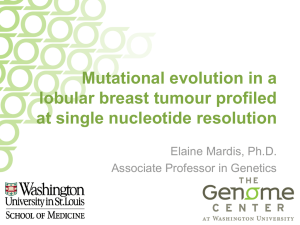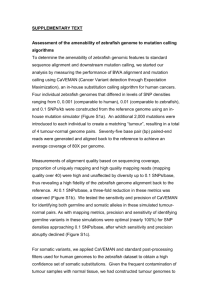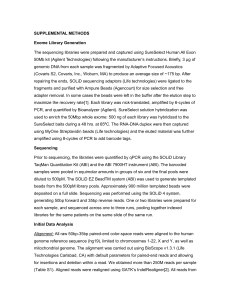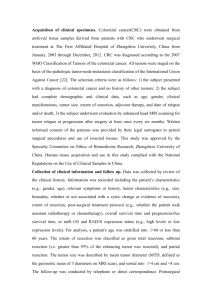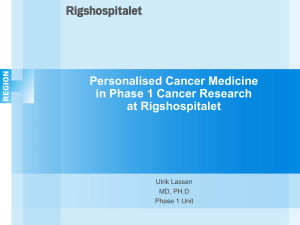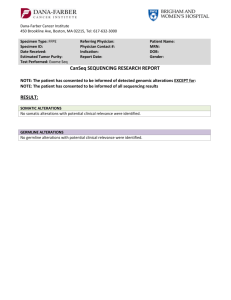Supplementary Data Materials & Methods Patient: Case History
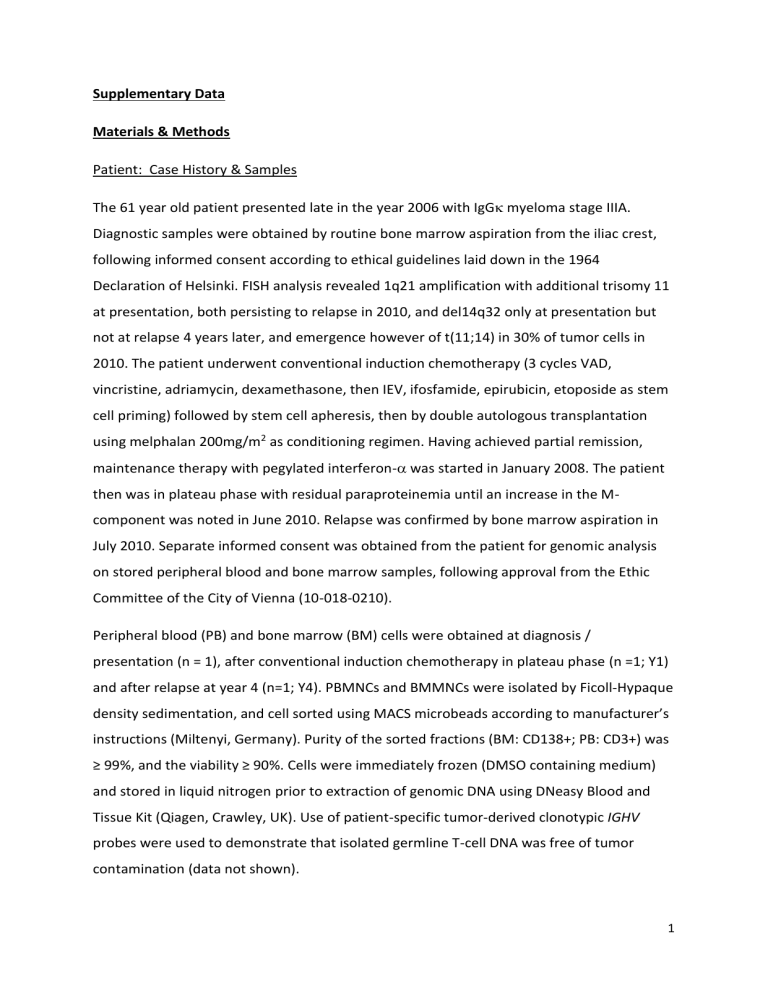
Supplementary Data
Materials & Methods
Patient: Case History & Samples
The 61 year old patient presented late in the year 2006 with IgG myeloma stage IIIA.
Diagnostic samples were obtained by routine bone marrow aspiration from the iliac crest, following informed consent according to ethical guidelines laid down in the 1964
Declaration of Helsinki. FISH analysis revealed 1q21 amplification with additional trisomy 11 at presentation, both persisting to relapse in 2010, and del14q32 only at presentation but not at relapse 4 years later, and emergence however of t(11;14) in 30% of tumor cells in
2010. The patient underwent conventional induction chemotherapy (3 cycles VAD, vincristine, adriamycin, dexamethasone, then IEV, ifosfamide, epirubicin, etoposide as stem cell priming) followed by stem cell apheresis, then by double autologous transplantation using melphalan 200mg/m 2 as conditioning regimen. Having achieved partial remission, maintenance therapy with pegylated interferon-
was started in January 2008. The patient then was in plateau phase with residual paraproteinemia until an increase in the Mcomponent was noted in June 2010. Relapse was confirmed by bone marrow aspiration in
July 2010. Separate informed consent was obtained from the patient for genomic analysis on stored peripheral blood and bone marrow samples, following approval from the Ethic
Committee of the City of Vienna (10-018-0210).
Peripheral blood (PB) and bone marrow (BM) cells were obtained at diagnosis / presentation (n = 1), after conventional induction chemotherapy in plateau phase (n =1; Y1) and after relapse at year 4 (n=1; Y4). PBMNCs and BMMNCs were isolated by Ficoll-Hypaque density sedimentation, and cell sorted using MACS microbeads according to manufacturer’s instructions (Miltenyi, Germany). Purity of the sorted fractions (BM: CD138+; PB: CD3+) was
≥ 99%, and the viability ≥ 90%. Cells were immediately frozen (DMSO containing medium) and stored in liquid nitrogen prior to extraction of genomic DNA using DNeasy Blood and
Tissue Kit (Qiagen, Crawley, UK). Use of patient-specific tumor-derived clonotypic IGHV probes were used to demonstrate that isolated germline T-cell DNA was free of tumor contamination (data not shown).
1
Exome Next Generation Sequencing
Preparation and enrichment of sequencing library was carried out from genomic DNA using
Agilent SureSelect Human All Exon 50M Kit, followed by generation of Illumina/Solexa
75+75 base sequences from each enriched library. Three exomes were sequenced: 1) germline T-cell DNA, 2) tumor DNA at presentation and 3) tumor DNA at relapse at 4 years
(Y4). DNA sequencing was carried out in the GenePool Genomics Facility in the University of
Edinburgh (kindly facilitated by Dr Karim Gharbi, Scientific Manager).
Exomes Bioinformatic Analysis
Exome sequence reads were aligned to the hg18 human reference genome using novoalignMPI (V2.07.11 - Build May 27 2011). Picard-tools (v1.34) and Samtools (v0.01.18) were used to merge, sort and manipulate sam and bam format aligned sequence files and create a ‘pileup’ of reads for each sample. Coverage statistics were calculated using bedtools (v2.13.2). Varscan (v2.2.8) was then used to call somatic SNV and indel variants.
Using the ‘somatic’, somaticFilter’ and ‘processSomatic’ options with the default parameter settings. This provides a list of ‘high confidence’ SNVs classified as somatic and LOH variants.
LOH variants were excluded from this analysis. Somatic p-values for a Fisher’s exact test of read counts for reference and alternative alleles in the two matched samples are provided by Varscan, and a threshold of significance of p<0.001 was required for all variants.
Germline, tumor at presentation and tumor at relapse (Y4) samples were treated as germline or tumor pairs to obtain a list of variants which were present at the various time points in three categories 0,1,0; 0,0,1 and 0,1,1. i.e. “0,0,1” not present in germline, not present in tumor at presentation but present at tumor relapse at year 4. All variants had a read depth >10.
Variants in these 3 categories were annotated using ANNOVAR (2012 Feb 23) to add gene and variant information including amino acid change, and information from dbSNP129 and dbSNP132, The 1000 Genomes Project, The Exome Sequencing Project. This allowed the lists to be filtered to include only nonsynonymous novel single nucleotide variants defined as those not present in dbSNP129, dbSNP132, The 1000 Genomes Project, or the NHLBI GO
2
Exome Sequencing Project (ESP). Novel variants are listed in Suppl. Table 1 and full metrics of data in Table 1.
Genes were assessed for presence of confirmed somatic mutations in the COSMIC database
(v59). All genes, except WDR73, have confirmed somatic mutations in COSMIC.
Genes were also cross referenced with the list of possible false positive genes from exome data published by Fuentes Fajardo et al.
11
Functional predictions were carried out using PolyPhen-2 (Polymorphism Phenotyping v2.2.2r398).
Evidence for deletions
An excess and co-localization of LOH variants (called by Varscan) coinciding with a drop in read depth in tumor versus germline samples suggests the presence of a large deletion. The average number of LOH variants called per chromosome in the 0,0,1 and 0,1,1 categories are 5.2 and 9.2 respectively. In the 0,0,1 category there are 89 LOH variants on chromosome
4 between 68.1 and 96.4Mb. On average the tumor read depth was 42.6% of the germline read depth across all LOH variants in this region suggesting a heterozygous deletion. In the
0,1,1 category there are 193 LOH variants on chromosome 16 between 45.2 and 88.7Mb.
On average the tumor read depth is 36.1% that of the germline sample suggesting a heterozygous deletion.
3


